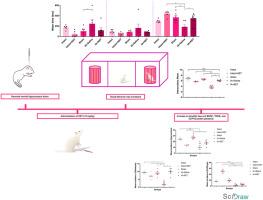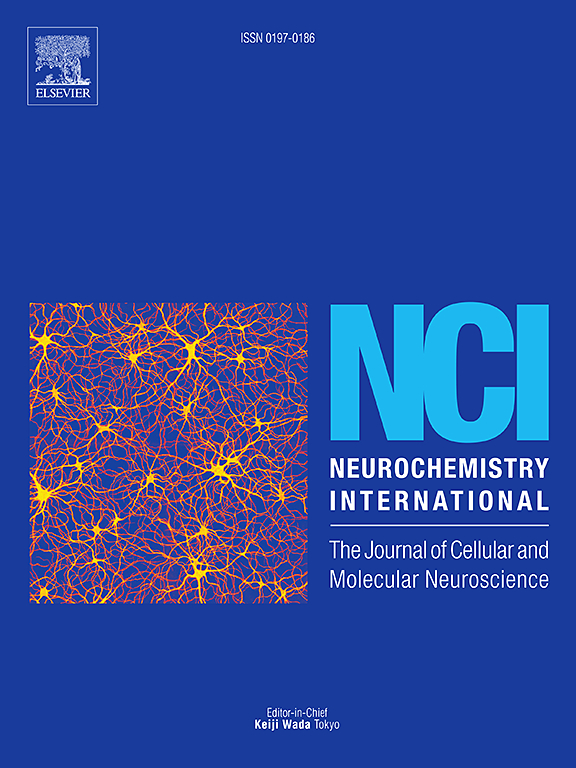Acute ketamine enhances social behavior and dendritic plasticity in the amygdala by increasing BDNF, GAP43, and TRKB presence following excitotoxic neonatal ibotenic acid lesion
IF 4
3区 医学
Q2 BIOCHEMISTRY & MOLECULAR BIOLOGY
引用次数: 0
Abstract
Schizophrenia is a highly disabling psychopathology that is a significant burden on public health systems and is characterized by both positive and negative symptoms. One of these negative symptoms is social isolation, which responds poorly to available treatments. Ketamine (KET) has been shown to enhance social behavior in various preclinical models, accompanied by neurobiological changes. In this study, we used a preclinical model of schizophrenia involving neonatal ventral hippocampal (NVHL) bilateral lesions induced by excitotoxicity with ibotenic acid (IA) at postnatal day 7 (PD). Thirty male Sprague-Dawley rats, aged 7 PD, were assigned to one of the following groups: Intact, Sham, Intact + KET, IA + Saline, and IA + KET, with n = 6 per group. Rats in the Sham, IA + Saline, and IA + KET groups underwent stereotaxic surgery and were administered with either 0.3 % saline or IA at 7 PD. At 35 PD, the rats received either saline or ketamine (15 mg/kg) and were assessed using the three-chamber social test. A Golgi-modified technique was then employed to evaluate neuronal changes in the amygdala with Sholl analysis. Also, immunohistochemistry was conducted to measure brain-derived neurotrophic factor (BDNF), tyrosine receptor kinase B (TRKB), and growth-associated protein 43 (GAP43). Acute KET treatment rescued social behavior, increased dendritic tree complexity, and elevated BDNF, TRKB, and GAP43 protein presence. Our results suggest that acute sub-anesthetic administration of KET may help alleviate social isolation symptoms. This dose could provide a window of opportunity to encourage individuals with schizophrenia to initiate and continue their treatment.

急性氯胺酮通过增加BDNF、GAP43和TRKB的存在,增强兴奋性新生儿伊博滕酸损伤后杏仁核的社交行为和树突可塑性。
精神分裂症是一种高度致残的精神病理学,是公共卫生系统的重大负担,其特征是阳性和阴性症状。这些负面症状之一是社会孤立,对现有治疗效果不佳。氯胺酮(KET)已被证明在各种临床前模型中增强社会行为,并伴有神经生物学变化。在这项研究中,我们使用了一个临床前精神分裂症模型,该模型涉及出生后第7天(PD)由伊博tenic酸(IA)兴奋性毒性引起的新生儿腹侧海马(NVHL)双侧病变。30只雄性sd - dawley大鼠,年龄7 PD,随机分为:完整组、假手术组、完整+KET组、IA+生理盐水组和IA+KET组,每组n = 6。Sham, IA+Saline和IA+KET组的大鼠进行立体定向手术,并在7 PD时给予0.3%生理盐水或IA。在35 PD时,大鼠接受生理盐水或氯胺酮(15 mg/kg),并使用三室社会测试进行评估。然后采用高尔基改良技术与Sholl分析来评估杏仁核中的神经元变化。免疫组化检测脑源性神经营养因子(BDNF)、酪氨酸受体激酶B (TRKB)和生长相关蛋白43 (GAP43)。急性KET治疗挽救了社会行为,增加了树突树的复杂性,并提高了BDNF、TRKB和GAP43蛋白的存在。我们的研究结果表明,急性亚麻醉给药可以帮助减轻社会隔离症状。这个剂量可以提供一个机会窗口,鼓励精神分裂症患者开始并继续他们的治疗。
本文章由计算机程序翻译,如有差异,请以英文原文为准。
求助全文
约1分钟内获得全文
求助全文
来源期刊

Neurochemistry international
医学-神经科学
CiteScore
8.40
自引率
2.40%
发文量
128
审稿时长
37 days
期刊介绍:
Neurochemistry International is devoted to the rapid publication of outstanding original articles and timely reviews in neurochemistry. Manuscripts on a broad range of topics will be considered, including molecular and cellular neurochemistry, neuropharmacology and genetic aspects of CNS function, neuroimmunology, metabolism as well as the neurochemistry of neurological and psychiatric disorders of the CNS.
 求助内容:
求助内容: 应助结果提醒方式:
应助结果提醒方式:


